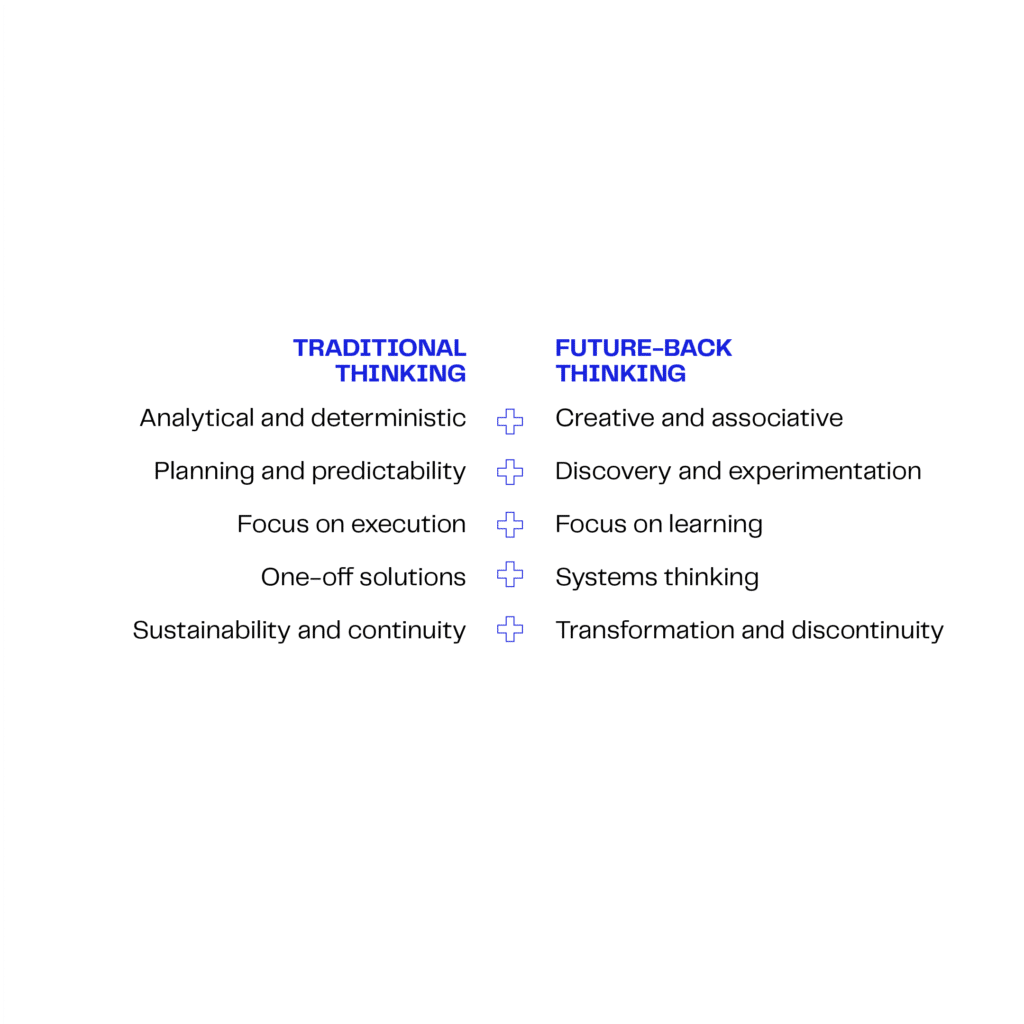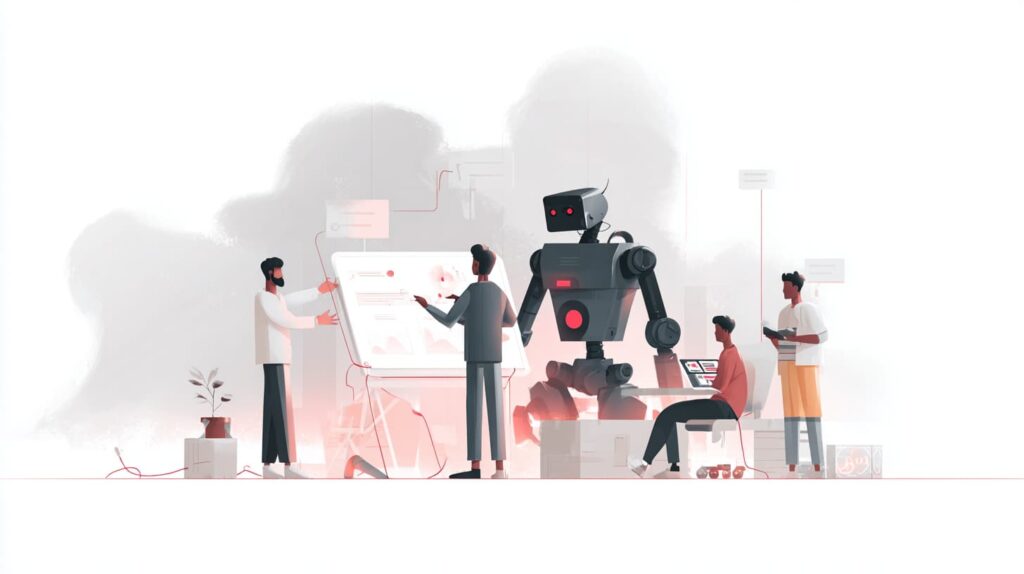By EloInsights
- When drawing up a strategy from the present for the future, organizations can miss important signals that point to disruptions and changes in the market game.
- The future back approach proposes a look that starts at a more distant horizon, beyond the company’s “comfort zone”.
- The process of “reverse engineering” this future allows organizations to understand gaps and establish growth initiatives that prepare them for the new scenario.
In the biographical literature of famous entrepreneurs around the world, the adjective “visionary” has become almost commonplace. As if the creators of companies that have found their success were born with some kind of supernatural power that gave them the ability to penetrate the veil of time and find the answers to the problems of each of their respective eras in the future.
But a disciplined analysis of the processes that led to the biggest technological disruptions in recent history shows that, regardless of any leader’s innate “genius”, there are problem-solving patterns that can be learned and incorporated into methodologies, allowing an organization to innovate sustainably, finding new avenues of value while strengthening and expanding its core business.
One of these approaches, used by EloGroup to implement structured innovation processes within companies, is known as “future back”. It was inspired by the work of several authors, such as Mark W. Johnson and Josh Suskewicz, writers of the book Lead from the Future: How to Turn Visionary Thinking Into Breakthrough Growth, and Professor Saras D. Sarasvathy, who has studied how successful entrepreneurs think about their businesses, as well as EloGroup’s own experience with innovation projects.
In this process, a little visionary ability will, indeed, be necessary, but, as we will describe below, this is not about having some supernatural gift. Instead, it is about adopting a practical and objective approach.
What research shows is that companies still set their visions and strategies based on short horizons, only on the premises found in the current market. This leaves them vulnerable to potential technological disruptions that occur beyond this narrow planning, making it impossible to capture value from them.
“The executive team is usually focused on delivering the day-to-day running of the organization. They need to ensure that projects are completed on time, put out a series of fires and this naturally takes up their energy”, describes Jaime Frenkel, executive director of innovation at EloGroup. “The problem is that, by doing this for too long, you do not realize that the rules of the game can change. Recent technologies and consumption models come in that can drastically change that rule”.
According to Frenkel, starting from the present to think about the future can leave companies vulnerable to disruption. “It is common for consumer goods companies, for example, to see innovation targets linked to the percentage of new products launched, but this ends up translating into the launch of a series of related products, with low uncertainty and greater sales guarantees, which do not consider likely future changes in consumer trends. So, basically, you are not addressing new customer needs”.

Vision vs Strategy
The vision should inspire the organization, defining its point of arrival or destination. It can define a “new game” to be played by the company and relates to choices made in the long term, over five years. The strategy operationalizes the vision and points the path to be followed. It projects how the organization is going to win in the game it has set out and relates to the choices made in the short term, over a horizon of one to three years.
A case study in this type of approach is Apple. At the end of the 1990s, shortly after Steve Jobs returned as CEO, the company was experiencing difficulties, partly due to a commoditization trend in the personal computer market. At the time, the company made a change of strategic direction and began to lay the foundations for what would become its long-term vision, which lasted more than two decades and is still in force today.
The company’s computers became digital “hubs” for a whole ecosystem of electronic devices that were turning popular at the time, such as digital photo and video cameras, MP3 players, etc. On one hand, the company would not give up investing in its core business, the manufacture of personal computers. On the other hand, it would explore new avenues of value, keeping an eye on how this new market could unfold, with strong potential for future evolution.
This change paid off quickly, with the launch of software like iTunes (2001), in which music could be bought and organized in a digital library, and iMovie (1999), which, to this day, functions as a more basic video editor for the MacOS operating system. But the company did not stop there and went on to manufacture its own electronic devices that would connect to its ecosystem, the iPod being the first of these and one of the most emblematic.
Gradually, release after release, the vision of an integrated digital hub, outlined at the turn of the 1990s into the 2000s, came to fruition. Nowadays, Apple has not only transformed several industries, such as music and telephony (especially after the announcement of the iPhone in 2007), but has also generated new sources of revenue, turning itself into the company of most value in the world.
Obviously, the company’s leadership did not have a perfectly sharp vision in 1998 of how the industry would behave 20 years later, no matter how much popular culture likes to emphasize the almost mythological “visionary” nature of entrepreneurs like Steve Jobs. What happened was that Apple’s leaders were able to look objectively at the market of their time, extract information from it and, from there, extrapolate a long-term vision defined enough for a concrete strategy to be implemented.
At no point did Apple stop making computers. On the contrary, in the long term, this strategy aimed at new markets has further strengthened the company’s core business and, to this day, Macs make up the center of this digital hub, in various categories.
How the future back approach works
From EloGroup’s perspective:
Step 1 - Define a vision of the future

“Our approach starts with building a very particular point of view on what the future of the business is going to be. What will change and, more importantly, what will not change in the dynamics of competition”, explains Frenkel. “To build this perspective, we first need to map out the signs of the future. This involves understanding: What are competitors doing? Where is venture capital investment going? What new business models are appearing? How are customers, consumers, changing their behavior?”.
The important thing is to define a hypothesis for the future. One that is aspirational and positive; then, set up an iterative learning process to test this hypothesis. Learn and adjust along the way.
To explain how defined this image of the future needs to be, we can compare it to an impressionist painting. This artistic movement, whose exponents include the painter Claude Monet, is better known for its ill-defined layout, with colors and boundaries of objects blending.
In other words, this means that, in the future back approach, the image of the future does not have to be comparable to a realistic high-definition photograph. But it rather brings the fundamentals that help make up that scenario, even if in a diffuse and imprecise way.
This image must then be cross-referenced with your organization’s current reality. How does it fit into this projected future? Is the core business still relevant? Does it have opportunities for growth, or does it face possible disruption? Are there any threats? Are they serious ones, which can drop your business model, or just moderate ones? Can they be seen as opportunities, offering good changes both in the core business and for new initiatives?
Finally, what role will your organization play in this future? Here, it is important to reflect on what gaps your core business has today to generate relevant value in this impressionistic long-term scenario. Initiatives that are next to the core and those that are completely new should not be left out. What would the version of your organization that is best prepared for everything that comes with this projection look like?
“The challenge is to create a point of view for the company of how the sector is changing and which innovations are going to make a difference. This requires a change in modus operandi, to allow these signs of the future to come in, reflect on them and create a point of view”, says Frenkel.
Step 2 - Turning the point of view into concrete innovation opportunities

“The next step is to turn this view of the future into concrete opportunities for growth and innovation for the company. To do this, we need to understand what the core business levers are”, points out Frenkel. “These levers are assets, competences and other types of resources that, as well as being crucial to sustaining core competition, can be re-signified to become a competitive advantage that allows the company to enter new businesses where it does not yet operate”.
To do this, we need to answer the following questions:
- What new value propositions can the organization bring to the market to meet emerging demands?
- What is the potential of these opportunities? Are they in line with the company’s appetite for growth?
- What competences and assets need to be developed, internally or externally, to make these opportunities viable?
- What hypotheses and uncertainties need to be validated before investing and diving headfirst into these opportunities?
- What is the order of magnitude of the investments that will need to be made to make the new business practical?
Frenkel explains that in this “reverse engineering” work, where the starting point is the future scenario, “it is impossible to execute all the opportunities in the portfolio, however attractive they may be”.
“It will be necessary to develop new competences, to make investments that cannot all be completed in the short term. Therefore, you must find regret-proof moves that allow the organization, at the same time, to buy new skills and generate incremental revenues that already show results for this whole innovation movement”.
It is also necessary to map out what experiments are needed today to guarantee truly disruptive innovation opportunities. The result of this discussion is an innovative roadmap that guides the organization’s efforts rather than defining a fixed path. “The roadmap will adapt as the context changes, as new information emerges”, concludes Frenkel.
Step 3 - Execute the strategy

“The third step is to execute this strategy. And to turn vision into reality, the company needs to organize itself”, says Frenkel. “It first needs a dedicated structure, created exclusively to work on these opportunities”.
The structure must include a high-potential team to make innovation happen. Another crucial point is the engagement of top management, which must learn to deal with uncertainty, which will be natural for these initiatives, and needs to sponsor them so that they happen, ensuring that the organization collaborates with them, removing barriers that will eventually arise.
It is also important to cultivate a test and learn mentality: failures are part of the journey. Learning from them is essential for a successful path to innovation.
In the end, we can see that building the future of an organization where there is sustainable growth and it is ready to deal with possible disruptions does not fundamentally involve crystal balls or the presence of “visionary” leaders, but rather other very objective elements. Including: ensuring openness to noticing signs of the future, which are already appearing in the present, through research and thorough analysis of the market and its consumers, as well as changes in the company’s structure that will ensure the stimulation of a mindset of testing and learning, and greater resilience to risk.
Thus, in a structured way, through a future back approach, it is possible to ensure that the organization is ready to generate value in a future scenario in which technological, cultural and consumer disruption will not just be a possibility, but an inevitable reality.











